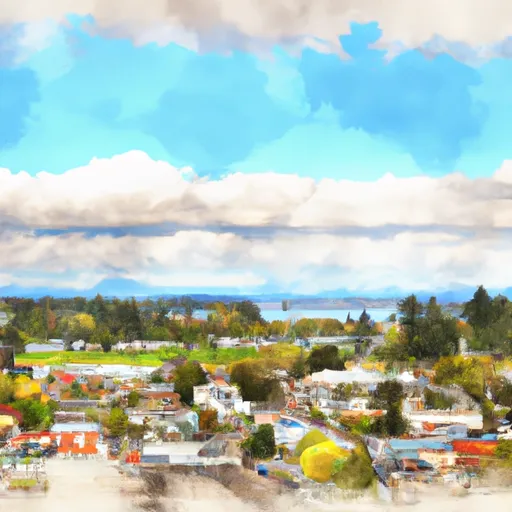-
 Snoflo Premium
Snoflo Premium
Get unlimited access to all our content
With no Ad interruptions! - Start Your Free Trial Login with existing account
Stanwood
Eden Index
Climate
8.1
•
Recreation
3.7
•
Community
3.7
•
Safeguard
5.5/10

Stanwood is a charming city located in Snohomish County, Washington. It experiences a mild, maritime climate with cool summers and wet winters. The average yearly temperature is around 52°F (11°C), with July being the warmest month and January the coldest. The area receives approximately 40 inches of rainfall annually, which contributes to the lush greenery and beautiful landscapes.
Hydrologically, Stanwood is situated near the Skagit River and Port Susan, offering stunning views of the waterways. The region is known for its diverse aquatic ecosystem, including salmon runs, shellfish beds, and various bird species. The hydrology constituents of Stanwood provide ample opportunities for fishing, boating, kayaking, and other water-based activities.
Outdoor enthusiasts can enjoy a plethora of recreational activities in Stanwood. The city is surrounded by natural beauty, with nearby attractions like Camano Island State Park and Kayak Point County Park offering opportunities for hiking, camping, and picnicking. Additionally, the area is a haven for birdwatchers and wildlife enthusiasts, with numerous parks and nature reserves to explore.
In conclusion, Stanwood, Washington offers a mild climate, picturesque hydrology constituents, and a wide range of outdoor recreation opportunities. Whether you're seeking adventures on the water or immersing yourself in nature, Stanwood has something to offer for everyone.
What is the Eden Index?
The Snoflo Eden Index serves as a comprehensive rating system for regions, evaluating their desirability through a holistic assessment of climate health, outdoor recreation opportunities, and natural disaster risk, acknowledging the profound impact of these factors on livability and well-being.
Climate Health Indicator (CHI): 8.1
Stanwood receives approximately
798mm of rain per year,
with humidity levels near 82%
and air temperatures averaging around
11°C.
Stanwood has a plant hardyness factor of
8, meaning
plants and agriculture in this region tend to thrive here all year round.
By considering the ideal temperature range, reliable water supplies, clean air, and stable seasonal rain or snowpacks, the Climate Health Indicator (CHI) underscores the significance of a healthy climate as the foundation for quality living.
A healthy climate is paramount for ensuring a high quality of life and livability in a region, fostering both physical well-being and environmental harmony. This can be characterized by ideal temperatures, reliable access to water supplies, clean air, and consistent seasonal rain or snowpacks.
Weather Forecast
Streamflow Conditions
Area Rivers
Snowpack Depths
Reservoir Storage Capacity
Groundwater Levels
Recreational Opportunity Index (ROI): 3.7
The Recreational Opportunity Index (ROI) recognizes the value of outdoor recreational options, such as parks, hiking trails, camping sites, and fishing spots, while acknowledging that climate plays a pivotal role in ensuring the comfort and consistency of these experiences.
Access to outdoor recreational opportunities, encompassing activities such as parks, hiking, camping, and fishing, is crucial for overall well-being, and the climate plays a pivotal role in enabling and enhancing these experiences, ensuring that individuals can engage in nature-based activities comfortably and consistently.
Camping Areas
| Campground | Campsites | Reservations | Toilets | Showers | Elevation |
|---|---|---|---|---|---|
| Riverfront RV Park - Sedro Woolley | 38 | 48 ft | |||
| Bay View State Park | 80 | 37 ft | |||
| South Whidbey Island State Park | 54 | 225 ft | |||
| Camano Island State Park | 88 | 181 ft | |||
| Kayak Point Regional Park | None | 8 ft | |||
| Wenberg County Park | 75 | 408 ft |
Nearby Ski Areas
Catastrophe Safeguard Index (CSI):
The Catastrophe Safeguard Index (CSI) recognizes that natural disaster risk, encompassing floods, fires, hurricanes, and tornadoes, can drastically affect safety and the overall appeal of an area.
The level of natural disaster risk in a region significantly affects safety and the overall livability, with climate change amplifying these risks by potentially increasing the frequency and intensity of events like floods, fires, hurricanes, and tornadoes, thereby posing substantial challenges to community resilience and well-being.
Community Resilience Indicator (CRI): 3.7
The Community Resilience Indicator (CRI) recognizes that education, healthcare, and socioeconomics are crucial to the well-being of a region. The CRI acknowledges the profound impact of these elements on residents' overall quality of life. By evaluating educational resources, healthcare accessibility, and economic inclusivity, the index captures the essential aspects that contribute to a thriving community, fostering resident satisfaction, equity, and social cohesion.

